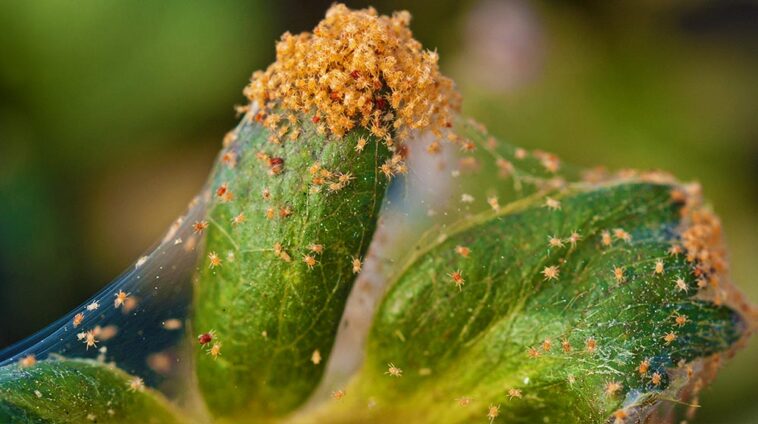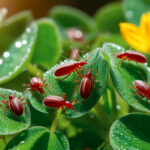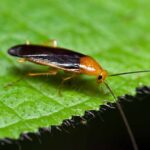Learn how to manage red spider mite infestations in your garden effectively. This comprehensive guide covers identification, biological and organic control methods, and the importance of maintaining a healthy garden ecosystem. Ensure your plants remain healthy by recognizing early signs, introducing natural predators, and employing cultural practices. Embrace Integrated Pest Management strategies for sustainable and environmentally friendly pest control solutions.
Understanding Red Spider Mites
Red spider mites, known scientifically as Tetranychus urticae, are tiny arachnids that can cause significant damage to garden plants. Their size ranges from 0.3 to 0.4 millimeters, making them difficult to spot with the naked eye. These pests have a characteristic red or reddish-brown coloration, which becomes more pronounced as they mature. Despite their minute size, their destructive potential is vast, primarily due to their prolific reproductive capabilities and their penchant for sucking the sap out of plants.
The first sign of red spider mite infestation is often a stippling effect, which appears as tiny, yellow or white spots on plant leaves. As the mites feed, they damage the chlorophyll within the leaves, causing them to lose their green color and eventually leading to a pale, mottled appearance. Over time, severely infested plants may exhibit symptoms such as leaf drop, stunted growth, and even death if the infestation is not controlled.
Behaviorally, red spider mites thrive in hot, dry conditions, which accelerates their lifecycle and boosts their reproductive rates. Under ideal conditions, a single female can produce several hundred eggs in her lifetime, leading to explosive population growth. Their ability to produce webbing on the underside of leaves further complicates their detection and enables them to shield their colonies from predators and environmental factors.
The damage inflicted by red spider mites is not just cosmetic. By sucking out plant juices, they weaken the plant’s immune system, leaving it more vulnerable to secondary infections and other pests. Moreover, they can cause significant economic losses in both ornamental and agricultural settings, making early detection and treatment crucial. Understanding the basic behaviors and signs of red spider mite infestations is the first step towards effective pest management and ensuring the health and vitality of your garden.
Identifying Infestations Early
Recognizing a red spider mite infestation at its onset is crucial for effective garden management. Early identification allows for timely intervention, minimizing potential damage to your plants. One of the first indicators of a red spider mite problem is the presence of tiny, discolored specks on the plant leaves, often appearing as yellow or white pinpricks. This stippling effect is a direct result of the mites feeding on the plant’s cellular contents.
Another common sign to be aware of is the appearance of fine, delicate webbing. These webs can be found on the underside of leaves, along the stems, and in the junctions where branches meet. While not always immediately noticeable, a careful inspection can reveal these webs, signaling the presence of red spider mites.
Changes in the overall health and appearance of your plants should also raise red flags. Look out for leaves that appear faded, bronzed, or have a silvery sheen. Drooping or curling foliage and reduced plant vigor are often symptoms of an advanced infestation. Regularly inspecting plants, especially those that are more prone to mite attacks like tomatoes, cucumbers, and peppers, can help catch these pests before they proliferate extensively.
Monitoring your garden consistently is paramount. Weekly inspections can considerably lower the risk of severe infestations. During these routine checks, carefully examine the underside of leaves and stem areas, as red spider mites typically colonize these sections first. Utilizing a magnifying glass can enhance detection, making it easier to spot these minuscule pests.
In conclusion, staying vigilant and recognizing the early signs of red spider mites—such as stippling, webbing, and discoloration—can play a pivotal role in maintaining a healthy garden. Regular garden inspections are not only a proactive measure but also a key to managing this pervasive pest effectively.
Biological control is an effective and environmentally friendly method to manage red spider mite populations in your garden. This strategy involves the use of natural predators to keep the pest numbers in check, reducing the need for chemical interventions. Common natural predators of red spider mites include ladybugs, predatory mites, and lacewings, each playing a vital role in maintaining a balanced ecosystem.
Ladybugs
Ladybugs, or lady beetles, are one of the most well-known allies in pest control. Both adult ladybugs and their larvae feed on red spider mites, making them highly effective in curbing infestations. To attract ladybugs to your garden, consider planting pollen and nectar-rich flowers such as daisies, marigolds, and yarrow. Additionally, providing a small water source can help sustain ladybug populations.
Predatory Mites
Predatory mites are another excellent resource for biological control. These mites specifically target spider mites and can significantly reduce their numbers. Species like Phytoseiulus persimilis and Amblyseius californicus are commonly used for this purpose. To introduce predatory mites into your garden, you can purchase them from reputable suppliers and release them in the infested areas. Maintaining a humid environment can also help these beneficial mites thrive.
Lacewings
Lacewings, particularly their larvae known as “aphid lions,” are voracious predators of red spider mites. These beneficial insects can be attracted to your garden by planting dill, fennel, and other flowering herbs. Lacewing eggs and larvae can also be purchased and released in your garden to boost their presence quickly.
Creating a hospitable environment for these natural predators involves some straightforward gardening practices. Avoid using broad-spectrum insecticides that can harm beneficial insects. Instead, focus on organic pest control methods and plant a variety of flowers and herbs to provide shelter and food sources. By integrating these natural predators into your garden management plan, you can achieve a healthier, more balanced garden ecosystem while effectively controlling red spider mite populations.
Cultural Practices to Prevent Infestation
Preventing red spider mite infestations in the garden starts with adopting effective cultural practices. Proper garden hygiene is paramount. Regularly remove plant debris, dead leaves, and weeds, as these can harbor spider mites and other pests. Ensure that your garden remains clean and tidy to create an unfavorable environment for mite colonization.
Adequate watering routines also play a critical role. Red spider mites thrive in dry conditions, making it essential to keep your plants well-watered. Employ practices such as regular irrigation and misting to maintain humidity around your plants. However, be cautious not to overwater, which can lead to other problems like root rot. Striking the right balance ensures healthy plant growth and reduces the likelihood of mite infestations.
The environmental conditions in your garden can significantly influence spider mite activity. Maintaining moderate humidity levels helps deter mites. Additionally, implementing shading structures or employing ground cover will minimize dust, reducing the likelihood of mites establishing themselves. Mulching can be particularly effective, as it retains soil moisture and helps regulate temperature. This practice not only benefits plant health but also disrupts the habitat that mites prefer.
Another effective strategy is to enhance air circulation within the garden. Pruning dense foliage and spacing out plants appropriately allow better airflow, reducing the stagnant conditions that mites favor. Regularly inspecting and rotating crops can also mitigate infestation risks. Early detection and removal of infested plants can prevent mites from spreading to healthy vegetation.
Ensuring a biologically diverse garden can act as a natural deterrent to red spider mites. Introducing beneficial insects such as predatory mites, ladybugs, and lacewings can help control mite populations. These natural predators will sustainably manage the mite population without the need for chemical interventions.
By implementing these cultural practices, gardeners can create an environment that discourages red spider mite infestations while promoting the overall health and vitality of their plants. Proper garden hygiene, adequate watering, optimal environmental conditions, and supporting natural predators are integral to maintaining a thriving and mite-free garden.
Organic and Homemade Solutions
When it comes to dealing with red spider mites, organic and homemade solutions offer a safe and effective alternative to chemical pesticides. These options not only target the mites but also preserve the health of your plants and the beneficial insects in your garden.
A popular and efficient method is the use of insecticidal soap. This involves mixing 2 tablespoons of mild liquid soap with 1 quart of water. Spray the mixture directly onto the affected areas of your plants, ensuring thorough coverage of the leaves’ undersides where red spider mites often congregate. This solution works by breaking down the mites’ protective outer layer, ultimately causing them to dehydrate and perish. Regular applications every five to seven days, especially during infestations, can keep the population under control effectively.
Neem oil is another potent organic remedy. To make a neem oil spray, mix 2 teaspoons of neem oil, 1 teaspoon of mild liquid soap, and 1 quart of water. Neem oil acts as an antifeedant and disrupts the mites’ hormonal systems, inhibiting their growth and reproduction. Apply the solution once a week until you see a noticeable reduction in mite activity, always during cooler parts of the day to prevent leaf burn.
Garlic spray can also be a useful homemade pesticide against red spider mites. Blend two to three garlic cloves with 2 cups of water and let it sit overnight. Strain the liquid and mix it with another quart of water. Garlic contains sulfur compounds that deter mites. Be sure to apply this solution in the evening as it may also affect some beneficial insects if used excessively.
These organic solutions, when used thoughtfully, not only help in controlling red spider mites but also maintain the ecological balance within your garden. By focusing on these safer alternatives, you ensure the health of your plants and foster a thriving environment for beneficial insects.
Chemical Treatments and When to Use Them
When dealing with red spider mites in your garden, chemical treatments can offer an effective solution, particularly when other methods have failed or when a rapid response is needed to protect your plants. Miticides are specifically formulated chemical agents that target spider mites, providing a precise and often immediate reduction in their population. It is essential, however, to understand when and how to deploy these treatments to achieve the best results while minimizing any adverse effects.
Before applying any chemical treatment, carefully read and adhere to the product instructions. Each miticide has unique application guidelines, dosage requirements, and safety precautions that must be followed to ensure effectiveness and safety. Overuse or misuse of these chemicals can lead to resistance in spider mite populations, making future infestations harder to control. Moreover, improper application can pose risks to non-target organisms, including beneficial insects like pollinators and natural predators of spider mites, as well as potentially harming the environment.
Consider the timing and frequency of chemical applications. Miticides are most effective when applied during a specific stage of the spider mites’ life cycle. Therefore, monitoring mite activity and adhering to recommended application schedules is crucial. Reapplications may be necessary, but they should always be executed within the intervals specified by the product label to prevent overexposure and undue environmental impact.
Environmental considerations are paramount when using chemical treatments. Whenever possible, opt for products with lower toxicity to non-target species and shorter environmental persistence. Additionally, ensure that applications are made during calm weather conditions to minimize drift and off-target exposure. Protective gear, such as gloves and masks, should be worn to safeguard personal health during the application process.
In conclusion, chemical treatments for red spider mites, while effective, must be used with caution and responsibility. By following product instructions diligently, considering the environmental implications, and taking necessary safety precautions, you can protect your garden from these persistent pests without causing undue harm to the broader ecosystem.
Integrated Pest Management (IPM)
Integrated Pest Management (IPM) is a comprehensive approach to controlling pests, including red spider mites, by combining multiple strategies that are environmentally friendly and sustainable. The primary goal of IPM is to maintain pest populations at manageable levels while minimizing the impact on non-target organisms, ecosystems, and human health. IPM is particularly effective for red spider mites due to its adaptability and integration of various control methods.
IPM strategies begin with cultural methods, which involve changing gardening practices to create environments unfavorable for red spider mites. This can include regular monitoring and scouting for mite activity, ensuring plants are adequately watered (as water-stressed plants are more susceptible), and rotating crops to prevent mite population buildup. Additionally, removing weeds and debris that may harbor mites contributes to cultural control.
Biological control is another crucial component of IPM. Introducing natural predators such as predatory mites, ladybugs, and lacewing larvae can significantly reduce red spider mite populations. These beneficial insects feed on red spider mites and help keep their numbers in check. Providing habitats that attract these natural predators, like nectar-rich flowers or ground cover, can enhance their presence in the garden.
Organic methods are also essential in the IPM framework. Employing organic miticides, such as neem oil, insecticidal soaps, or horticultural oils, can effectively target red spider mites while being less harmful to beneficial insects and the environment. It’s important to apply these products precisely and according to their instructions to maximize their efficacy and sustainability.
While cultural, biological, and organic methods are often sufficient, chemical control may sometimes be necessary. When using chemical pesticides, one should opt for targeted miticides and apply them as a last resort. Integrated Pest Management emphasizes the responsible use of chemicals, advocating for selective, rather than broad-spectrum, pesticides to reduce the likelihood of harming beneficial insects.
In summary, IPM provides a balanced and multifaceted approach to managing red spider mites. By integrating cultural practices, biological controls, organic treatments, and judicious chemical use, gardeners can effectively control these pests while promoting a healthier and more resilient garden ecosystem.
Maintaining a Healthy Garden Ecosystem
An integral part of managing red spider mites and ensuring your garden flourishes is maintaining a healthy garden ecosystem. This holistic approach not only addresses current infestations but also creates an environment that deters pests in the future. Here, we focus on the key elements necessary for a resilient and balanced garden.
First and foremost, soil health stands as the foundation of a thriving garden. Ensuring your soil is rich in nutrients will bolster plant vigor and increase natural resistance to pests, including red spider mites. Regularly amend the soil with compost, organic matter, and mulch to maintain its fertility and structure. A nutrient-dense substrate promotes robust root systems, making plants less susceptible to infestations.
Plant diversity is another crucial factor in fostering a balanced ecosystem. A wide variety of plants provides different habitats and food sources for beneficial insects and organisms that prey on red spider mites and other pests. Introduce a mix of flowers, herbs, and vegetables in your garden to cultivate biodiversity. This heterogeneous plant community can significantly curb the proliferation of any single pest species.
Creating a balanced environment extends to the inclusion of natural predators in your garden. Encourage populations of beneficial insects such as ladybugs, predatory mites, and lacewings. These allies feast on red spider mites, providing a natural method of control. You can attract these beneficial insects by planting native plants, minimizing pesticide use, and providing adequate water sources.
Lastly, regular garden maintenance is paramount. Vigilant monitoring, timely pruning, and prompt removal of infested plants or plant debris can prevent pest outbreaks from escalating. Watering practices also play a role; proper irrigation prevents plant stress, which can invite red spider mites.
By integrating these strategies, you will not only manage red spider mite populations effectively but also cultivate a healthy and resilient garden ecosystem. This comprehensive approach to garden care serves as the best long-term solution for preventing red spider mite infestations.




GIPHY App Key not set. Please check settings